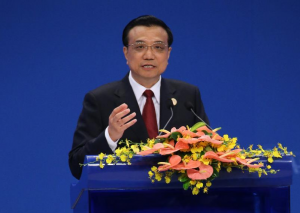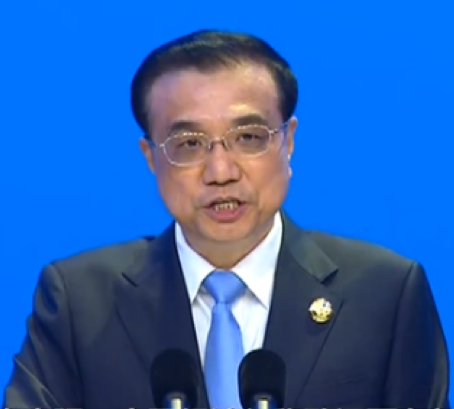aNewDomain, Bo’ao, Hainan, China — Chinese Premier Li Keqiang offered up his “deepest condolences” to victims of the recent bombing attacks in Brussels, adding that China continues to strongly oppose terrorism “in each and every form.”
 Li said this during his comments at the opening keynote here at the Boao Forum for Asia (BFA 2016) in Bo’ao, a resort city on the island of Hainan in southern China. Prime ministers from Russia, Korea, Vietnam, Thailand, Nepal, Lithuania, Laos, Kazakhstan, Cambodia and Myanmar spoke afterward, as did former Japanese Prime Minister Yasuo Fukuda, who chairs the conference.
Li said this during his comments at the opening keynote here at the Boao Forum for Asia (BFA 2016) in Bo’ao, a resort city on the island of Hainan in southern China. Prime ministers from Russia, Korea, Vietnam, Thailand, Nepal, Lithuania, Laos, Kazakhstan, Cambodia and Myanmar spoke afterward, as did former Japanese Prime Minister Yasuo Fukuda, who chairs the conference.
On the schedule today, but notably missing, was Belgian Prime Minister Charles Michel.
A representative told aNewDomain that Michel had cancelled his planned visit to China so he could deal with the emergency.
More than 200 people were injured and some 34 people killed in two attacks in Brussels International Airport in the bombing of a rush hour subway train.
In his remarks, Li also commented extensively on economic issues, which are the primary focus of this conference. Asia’s rapid growth over the last few decades, he noted, is largely due to the fact that Asian countries have been able to maintain peaceful relations. He urged the prime ministers in attendance to be “good neighbors,” adding that “minor frictions must not be allowed” to disrupt Asia’s role as a primary driver of world economies.
I’ve pasted the full text of Li Keqiang’s speech as he delivered it at the 2016 Boao Forum for Asia (BFA 2016), on March 24, 2016.
Distinguished guests, ladies and gentleman and dear friends,
I am delighted to be back for the Boao Forum for Asia Annual Conference and to meet with so many friends, both old and new. On behalf of the Chinese government, let me extend warm congratulations on the opening of this year’s annual conference and give my hearty welcome to all participants coming from afar.
Just two days ago, Belgium was hit by serious terrorist attacks, and Prime Minister Charles Michel had to cancel his scheduled attendance and address today. Here, we give our deep condolences to the families of the victims. China stands firmly opposed to terrorism of all forms.
We gather here in Boao at the beginning of the spring season, on an enchanting and peaceful day. But looking at the global economy, we see difficulties lingering and undercurrents lurking. Boao brings together heads of government and leaders from businesses, think tanks and the media.
I look forward to hearing your wisdom and insights about how we could together open up a new vision for a dynamic Asia.
Today, almost eight years after the international financial crisis struck, the ripples of its implication are still being felt around the world. The world economy is going through profound adjustments. Developed economies are experiencing slow recovery and emerging economies are performing unevenly. Global trade continues to contract, and both global commodities prices and financial markets are fluctuating. Geopolitical risks are growing, and uncertainties and destabilizing factors are on the rise.
In Asia, the problems of underdevelopment and imbalances remain acute. Many Asian countries are faced with export decline, growing debts, and economic slowdown. Some have even witnessed sharp depreciation of their currencies coupled with faster capital flight. No wonder some say that the Asian economy is facing one of the toughest times in recent years.
While things may not look good, we must not lose confidence. The truth is, Asia has emerged only stronger from the two previous financial crises. Quite many Asian countries have become much more experienced as to how to beef up the real economy and fend off financial risks.
Regional cooperation in Asia has also delivered fruitful results. Last year, growth in Asia was still faster than the global average. Asia’s share in the global economy further increased, and Asia contributed to about one third of global trade. This part of the world has remained one of the most dynamic globally.
At last year’s annual conference, President Xi Jinping put forward the major initiative to build a community of shared destiny and open up a new future for Asia. The theme of this year’s annual conference is “Asia’s New Future: New Dynamics, New Vision”. The community that we are committed to build is one of development and cooperation.
Asia is a major force for world peace and development, as well as a major engine driving world economic growth. It is also an important factor promoting progress of world civilizations. As long as Asian countries work together with firm commitment and unity, we will be able to get over difficulties and embrace an even brighter future. Along that line, I wish to share the following thoughts with you:
First, we need to jointly uphold peace and stability. When we drink water, we should not forget its source. Asia owes the past decades of rapid growth to an environment of overall peace and stability in the region. As the saying goes, good neighbors mean good life. The past sufferings of war and turmoil have taught the Asian people the value of peace. Asia’s post-war development shows that at all development stages, we must stay committed to good-neighborliness and must never let the minor differences or disagreements between us stand in our way.
It is through dialogue and cooperation that we could find the “golden key” to development. We need to continue to treat each other as equals and live with each other in peace, and we need to work together to increase common ground, reduce differences, and build a solid foundation for peace and stability in the region.
Second, we need to jointly promote economic growth. Emerging economies and developing countries now account for 40% of the global economy. They once contributed up to two thirds of the growth of the world economy, and played a major role in the global efforts to tackle the 2008 financial crisis. But things have been tough over the past two years, as some of them have experienced significant economic slowdown and even negative growth. Asia, which is home to the largest number of emerging economies, has on the whole maintained a strong growth momentum.
Last year, the growth of developing economies in Asia reached 6.5% and accounted for 44% of global growth. Therefore, Asian nations should enhance confidence, foster new impetus of growth from within, and stimulate vitality to play a bigger role for economic recovery not only in this part of the world but also globally.
It is our hope that countries in the world will join hands to deepen cooperation, form synergy, strengthen macro-policy coordination, oppose trade protectionism of all forms, adopt more growth-friendly policies, and try to avoid the spillover effect of the policy adjustments in certain countries.
China proposes establishment of an Asian Financial Cooperation Association, and China stands ready to work with all parties to improve Asia’s financial market and prevent massive regional financial turbulence from happening again.
Third, we need to jointly deepen integrated development. To achieve development and prosperity in Asia, we must make sure that no one is left behind.
China hopes to align its initiative of building the Silk Road Economic Belt and the 21st Century Maritime Silk Road with the development strategies of other countries in the region and regional organizations.
Together, we could foster a new pattern of regional development through integrated planning and production and coordinated actions. China is ready to provide high quality and cost-effective equipment and production-lines that could tailor to the needs of Asian countries. We may carry out production capacity cooperation in infrastructure building and industrial equipment making.
The Regional Comprehensive Economic Partnership (RCEP) is the biggest regional trade arrangement in Asia that attracts the largest number of participating members, and we hope that negotiations under the RCEP could be concluded by 2016. For the Asian Infrastructure Investment Bank and the Silk Road Fund, their priority should be placed on serving developing countries of Asia first, and on connectivity and production capacity cooperation projects, so that people in the region could share in the benefits of such integrated development.
Fourth, we need to jointly uphold openness and inclusiveness. Being open and inclusive is the fine tradition and very basis of Asia’s culture. In Asia, over the millennia, different nations, religions and cultures have coexisted with and learned from each other and all have contributed their major share to the progress of human civilization. Almost all religions with world-wide influence originated from Asia.
The people in Asia crave for peace, good-neighborliness and harmony. It is this piece of land that has given birth to the Five Principles of Peaceful Coexistence, and brought into being the Asian way, highlighting mutual respect, consensus building and accommodating the comfort level of all parties concerned.
Asian countries are linked by close people-to-people exchanges. Each year, several hundred million tourists travel among Asian countries. We need to make good use of all dialogue platforms in Asia to deepen people-to-people exchanges and enhance the unity of Asia. China proposes that an Asia Civilization Dialogue Conference be held and we welcome all countries and regional organizations to take an active part in the conference.
The more challenging the task of development is in the region, the more imperative it is for us to join hands, build on our traditional friendship and pool our collective wisdom, so as to carry forward the Asian Consensus and achieve our common pursuit for development.
Fifth, we need to work jointly to trigger innovation. Innovation holds the key to development. Asia is home to 48 countries and over four billion population, and the “Asian miracle” was created by the talented and hard-working Asian people.
To keep up the momentum of prosperity and development in Asia, we need to give full play to Asia’s unique advantage of abundant human resources, and bring out the potential and creativity of all its people.
Asia’s new future relies on innovation and talented personnel. We need to improve education and training in Asia to build a high-quality labor force, strengthen the talent pool and increase productivity. We need to step up R&D investment, adopt new models of development, including the “Internet Plus” model, and build cooperation platforms for innovation to develop the new economy and a shared economy.
We may also conduct due exchange of experience. This way, the hundreds of millions of our people, especially the young people, will have the chance to engage in innovation and entrepreneurship, and have their ingenuity and creativity fully unleashed. This also allows countries in the region to quickly embark on a path of innovation-driven development and upgrade the level of growth.
China’s development is closely linked with that of Asia, and I know that many friends are interested in the economic situation in China.
So I wish to take this opportunity to say something about how we should look at the Chinese economy and what we intend to do in China to ensure continued growth.
First, how should we look at the Chinese economy? China’s total GDP last year was RMB67.7 trillion yuan, or over US$10 trillion. Every move of this economy attracts world attention. Meanwhile, China is in the process of structural readjustment, and there is divergence among different regions and sectors.
This is like what a Chinese poem says, one gets different impressions of a mountain when viewing it from the front, sideways, at a close range or from afar. Given the sluggish growth of the world economy, the lowest ever in six years, and with the Chinese economy undergoing transformation and upgrading, it is simply natural that different people may see the Chinese economy differently.
In my view, when we look at the Chinese economy, we should first of all look at its overall performance. Last year, China grew by 6.9%, a bit slower than in the past, but still one of the fastest among the major economies.
It was achieved on the basis of the huge size of the economy which was in the process of transformation. Since the beginning of this year, the Chinese economy has on the whole enjoyed steady performance and seen new, positive changes. The number of measures we introduced to promote steady growth, restructuring and reform are being paid off.
Second, we need to look at the overall trend of the economy. According to the National Bureau of Statistics, over 13 million new jobs were created in China’s urban areas last year, and the growth of people’s income was faster than that of the GDP. The employment situation in the first two months of the year has stayed basically stable, with surveyed unemployment rate standing at around 5.1% in 31 major cities, roughly the same as last year. As industrial upgrading picked up speed, the service sector, high-tech industries and equipment manufacturing industries all maintained fast growth. Domestic demand continued to rise, and consumption growth stayed at double digit. Consumption and services have now become the main drivers of growth. Both energy intensity and the discharge of main pollutants went down, an indication that the quality of growth is getting better.
Third, we need to look at the prospect of the economy for the long run. China has become the world’s second largest economy, but its per capita GDP is still at the middle level in the world. There is both a gap to fill and a potential to tap, especially in China’s central and western regions, where we see huge space and room for development. China is now in the process of industrialization and urbanization. There is strong impetus for reform and much space for expanding domestic demand. Development is resilient, and the tools are many to boost innovation. The fundamentals of the Chinese economy have stayed unchanged and will remain sound in the long run.
Of course, we are fully aware that the Chinese economy is now deeply integrated with the world economy. Some international agencies have lowered the growth forecast for this year and destabilizing factors and uncertainties are on the rise. The impact will be felt in the Chinese economy.
At the same time, in China, the deep-seated structural problems have become more prominent, and the economy still faces growing downward pressure. As the economy goes through transformation and upgrading, temporary problems have occurred, and companies in certain industries are facing a hard time with their operation.
We will not dodge these problems. In fact, knowing where problems are have made us all the more confident. We will expand aggregate demand as appropriate, and at the same time press ahead with structural reform, supply-side structural reform in particular. On the whole, for the Chinese economy, we believe there are more hopes than difficulties.
Next, what do we intend to do to ensure continued growth? The Government Work Report adopted by the NPC has laid that out in great detail. Yesterday evening, we took the bullet train to travel from Sanya to Boao. A bullet train is powered not just by its locomotive, but also the facilities installed in between carriages.
If we are to compare the Chinese economy to a bullet train, what we need to do is to keep it steady and move at a reasonable speed. With growing environmental and resources constraints, high-speed is not economical; nor is it environment friendly or sustainable. Our goal is to maintain medium-high speed of growth.
China’s development will be guided by the new vision of innovative, coordinated, green, open and shared development. We will continue to give priority to development, and work to build dynamic engines to propel the economy, making sure that it maintains medium-high speed growth and moves towards the medium-to-high end of development.
Like running a bullet train, to develop the economy, the first thing is stability and safety. In the past few years, we have adopted innovative approaches to macro-control, including a new range-based approach.
We have set it our upper limit to keep price rises in control and our minimum target to ensure sufficient employment. This range-based approach has effectively stabilized market expectations.
This year, we expect the economy to grow by 6.5%-7%, a new range designed to allow certain flexibility with the growth target. Short-term and minor fluctuations in the economy can hardly be avoidable. We will not try to redress these minor fluctuations with moves that are against market rules.
But once the economy slips out of the reasonable range, we will definitely take overarching measures in line with the laws of the economy. Currently, the debt-to-GDP ratio of the Chinese government is less than 40%, and for the central government, it is only 17%. We also have a high savings rate.
The space is ample to develop a multi-tiered capital market, and new tools are available to introduce innovative regulatory measures to the financial sector. We are not only well positioned to prevent systemic, regional financial risks, but also supported by enough policy tools to keep the economy steady.
Last year, for instance, with collaboration among relevant agencies and financial institutions, special funds for specific projects were raised and used based on market-based approaches to expand effective investment. Such an approach strongly facilitated economic restructuring and ensured steady growth. This year, we will continue this practice.
For the Chinese economy to move steadily forward for the long run, we need to stimulate internal forces and develop new engines.
The growth momentum comes, first and foremost, from reform and opening-up. The rapid development of the Chinese economy over the past three decades proves that as long as reform continues, the economy will keep going forward.
This year, we will continue to deepen such reforms as streamlining administration, delegating powers, and improving oversight and services. We will provide easier market access. The government can focus more on ongoing and ex-post supervision, step up protection of intellectual property rights, fight against fake and substandard products, create a level-playing field for competition, and boost market vitality and social creativity.
We will actively promote reforms of the fiscal and financial systems. For example, business tax will be replaced with VAT in all sectors, a major step of structural reform that will save businesses more than RMB500 billion in tax. This will not only help us form a consistent tax system and eliminate double taxation.
More importantly, it will strongly boost the development of the service industry, especially high-end services, such as R&D, and support the transformation and upgrading of the manufacturing sector. Most enterprises will benefit from the tax reduction to varying degrees, and small and micro businesses will see their tax burden significantly lightened. In times of fiscal difficulties, the government is doing this to release more water to nourish the fish in the pond, i.e. to generate continued momentum of growth with a short-term drop in fiscal revenue. It is also indicative of the room for fiscal flexibility left at our disposal.
Let me give you another example. For reforms in the financial sector, we can explore market-based approaches for debt-for-equity swap to help lower corporate leverage ratio.
Greater openness is also a way of reform. We will open the country wider to the outside world, including orderly opening of the services, financial and other sectors, and make China a most preferred destination for foreign investment with more opportunities and better environment.
The year before last, we launched the Shanghai-Hongkong Stock Connect. This was a major step in opening up China’s capital market. At an appropriate time this year, the Shenzhen-Hongkong Stock Connect will also be launched. We will continue to maintain the basic stability of the RMB exchange rate at an adaptive and equilibrium level. The economic fundamentals are such that allows for no basis for continued depreciation of the RMB exchange rate.
China is a responsible major country. We will continue to make the RMB exchange rate more market-oriented by acting on the principles of voluntarism, gradualism and controllability. We will not fight a currency war, and will never stimulate export by depreciating the currency.
The growth momentum comes from restructuring. Restructuring holds the key to economic transformation. We will actively develop the new economy, foster new engines of growth while upgrading traditional engines, and build the “twin engines” for development. In this process, we will reduce overcapacity, particularly in the coal, iron, steel and other industries that are experiencing difficulties.
We will also foster new growth areas, follow an innovation-driven strategy, encourage mass entrepreneurship and innovation, further develop the service sector, high-tech industries, SMEs and micro companies, carry out the strategy of Made in China 2025, and increase the competitiveness of the real economy.
In the process of reducing overcapacity, we may need to resettle and rearrange for some employees. However, thanks to the development of the new economy and new drivers of growth, a host of new businesses and industries have emerged, bringing along many new job opportunities and providing the conditions for upgrading traditional industries. Governments at all levels should, acting under the pressure of market forces, help employees get new jobs, and arrange for basic living necessities for those who face temporary difficulties. Both the central and local governments should bear these responsibilities.
At the same time, we will actively advance urbanization, and that is the biggest source of potential domestic demand. We will expand effective investment, such as those in infrastructure, to remove obstacles, improve the environment and create better conditions to upgrade the consumption level and improve people’s lives.
This will also promote the development of agriculture and the rural areas, propel agricultural modernization, and continuously increase farmers’ income.
The growth momentum comes from efforts to improve people’s livelihood. Development should result in better livelihood. The new jobs created as a result of improved livelihood will in turn help boost consumption and economic development. In other words, to improve people’s lives, development is something imperative, and development is also a litmus test to the success of reform.
The day before yesterday, I visited a tourist center in Sanya where I found a group of university graduates who were enthusiastic participants in the mass entrepreneurship and innovation program in tourism. They turned agricultural produce into handicrafts and travel souvenirs, and developed special tools to meet people’s daily need. There, tourism becomes an integrated business covering the first, second and tertiary sectors, which makes it different from traditional tourism.
Over the past five years, tourism revenue in China grew by 19% on average. Last year, four billion domestic travels were made. This gave a strong boost to the expansion and upgrading of household spending, and in particular, created many job opportunities.
This is only one example of the development of new economy and better life of the people. This year, to ensure and improve people’s livelihood, we will continue to focus on fostering a “safety net” covering the five major areas of employment, education, medical care, pension benefits and housing. We will ensure that the people are employed and paid for their work, and people of the right age enjoy equal opportunities of education.
We will gradually resolve the problem of access to and affordability of medical services, and make sure that pension funds play the role of ensuring basic and subsistence needs for the old-aged. This year, we will continue to renovate rundown areas and dilapidated old urban houses.
We will combine the measures of reducing housing inventory with cash subsidies to relocate people from rundown areas, and better meet the justified housing need of our people. In addition, we will adopt differentiated measures, based on local conditions in different cities, to promote the stable and healthy development of the housing market.
We will pay particular attention to poverty relief and make tremendous efforts to reduce poverty, so as to narrow the gap between the rich and the poor and achieve inclusive development.
Eventually, the growth momentum comes from the vigor and creativity of the Chinese people. China is the largest developing country, with over 1.3 billion population. Hundreds of millions of them are skilled professionals with higher education background.
In the next five years, 30 to 40 million more will graduate from college. To leverage our strength in labor supply and human resources will unleash the greatest potential and momentum for development.
We will improve incentive mechanisms to encourage science professionals to devote themselves to innovation, and in return, they will be held in high respect and receive reasonable returns for their achievements. We will develop better methods for performance evaluation to mobilize the enthusiasm of officials in doing their job and showing initiative. We will build platforms and create conditions to support SMEs while they embrace and become part of the new economy. At the same time, we will transform and upgrade traditional engines for the economy. This way, those interested in starting their own businesses or introducing innovations will be able to put aside any burden they may carry, feel free to act, and make their life worthwhile in the process of creating social wealth. The wisdom and creativity of hundreds of millions of people will be pooled together into an incomparable force for development, taking the Chinese economy over various hurdles and onto new levels.
An upgraded Chinese economy means not only self-improvement for China but also opportunities for the world. Many countries in Asia are China’s close neighbors and they will naturally be the first to benefit from China’s development. A few days ago, China released the 13th Five-Year Plan for Economic and Social Development, which will take China towards the ambitious goal of finishing building a moderately prosperous society in all respects.
In the next five years, China’s economy will grow at an average annual rate of above 6.5%, import over US$10 trillion of goods, and make US$600 billion of outbound investment. Several hundred big projects and programs will be launched and put into operation. This will be an open process to be shared by all.
I hope that the business communities present here will seize the good opportunity and achieve big success.
It has been 15 years since the Boao Forum for Asia came into being. These 15 years have witnessed Asia’s remarkable development achievements, which is in fact the best and fastest growing period in Asia’s history.
As the saying goes, “small things add up to become something really big.” As long as we work together to foster new dynamics for our economies, we will surely open up a new vision for regional development and embrace a more invigorated new future for Asia.
To conclude, I wish this annual conference a complete success.
Thank you.
For aNewDomain, reporting here in Bo’ao, Hainan Province, China, I’m Gina Smith.












